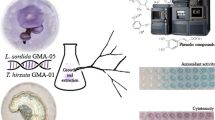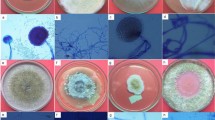Abstract
A wild strain of Schizophyllum commune (MTCC 9670) isolated from Achanakmar-Amarkantak Biosphere Reserve of Central India was evaluated for the production of bioactive compounds. The chemical constituents of wild and in vitro grown cultures were compared. Under optimized conditions, different organic and aqueous extracts from mycelia and fruiting bodies were used to extract chemical components from the cultures grown in vitro. The gas chromatography combined wih mass spectrometry analysis of extracts identified two phenolic compounds, namely Phenyl benzoate (C13H10O2) and 4-(phenyl methoxy) phenol (C13H12O2) in the ethanolic extract of in vitro grown fruiting bodies and one antibacterial compound Pyrrolo (1, 2-a) piperazine-3, 6-dione (C7H10O2N2) in the methanolic extract of mycelia. High-performance liquid chromatography analysis revealed that the gallic acid and l-ascorbic acid were identifiable antioxidant components in the extracts possessing high free radical scavenging activity. The findings suggest that the wild strain of S. commune may serve as the source of novel bioactive compounds with effective antimicrobial and antioxidant activities.




Similar content being viewed by others
References
Adejoye OD, Adebayo-Tayo BC, Ogunjobi AA, Afolabi OO (2007) Physicochemical studies on Schizophyllum commune (Fries) a Nigerian edible fungus. WASJ 2:73–76
Aina DA, Oloke JK, Jonathan SG, Olawuyi OJ (2012) Comparative assessment of mycelia biomass and exo-polysaccharide production of wild type and mutant strains of Schizophyllum commune grown in submerged liquid medium. Nat Sci 10:82–89
Ajith TA, Janardhanan KK (2007) Indian medicinal mushrooms as a source of antioxidant and antitumor agents. J Clin Biochem Nutr 40:157–162
Alam N, Cha YJ, Shim MJ, Lee TS, Lee UY (2010) Cultural conditions for mycelia growth and molecular phylogenetic relationship in different wild strains of Schizophyllum commune. Mycobiology 38:17–25
Arora D (1986) Mushrooms demystified, 2nd edn. Ten speed press, Berkeley
Asatiani MD, Elisashvili VI, Wasser SP, Reznick AZ, Nevo E (2007) Free radical scavenging activity of submerged mycelium extracts from higher basidiomycetes mushrooms. Biosci Biotechnol Biochem 71:3090–3092
Balchandran C, Duraipandiyan V, Ignacimuthu S (2010) Cytotoxic (A549) and antimicrobial effects of Methylobacterim sp. isolate (ERI-135) from Nilgiris forest soils, India. Asian Pac J Trop Biomed 2:712–716
Bao HND, Ochiai Y, Ohshima T (2010) Antioxidative activities of hydrophilic extracts prepared from the fruiting body and spent culture medium of Flammulina velutipes. Bioresour Technol 101:6248–6255
Barros L, Calhelha RC, Vaz JA, Ferreira ICFR, Baptista P, Estevinho LM (2007) Antimicrobial activity and bioactive compounds of Portuguese wild edible mushrooms methanolic extracts. Eur Food Res Technol 225:151–156
Bitew A (2010) Antibacterial and antifungal activities of culture filtrate extract of Pyrofomes demidoffii (basidiomycete). WASJ 10:861–866
Boddington M (2009) Discovery and evaluation of novel antimicrobial agents against nosocomial pathogens. Dissertation, University of Southern Queensland
Bolla K, Shaheen SZ, Kandukuri V, Singara Charya MA (2008) Effect of oils on the production of exopolysaccharides and mycelia biomass in submerged culture of Schizophyllum commune. Afr J Microbiol Res 2:349–352
Chen W, Zhao Z, Chen SF, Li YQ (2008) Optimization for the production of exopolysaccharide from Fomes fomentarius in submerged culture and its antitumor effect in vitro. Bioresour Technol 99:3187–3194
Cheung LM, Cheung PCK, Ooi VEC (2003) Antioxidant activity and total phenolics of edible mushroom extracts. Food Chem 81:249–255
Choi Y, Lee SM, Chun J, Lee HB, Lee J (2006) Influence of heat treatment on the antioxidant activities and polyphenolic compounds of Shittake (Lentinus edodes) mushroom. Food Chem 99:381–387
Chung KS, Chung SH, Kim BK (1988) Studies on the antibiotic constituents of Korean basidiomycetes (IV). Preliminary examination of the mycelia cultures of the 17 basidiomycetes strains. Arch Pharm Res 11:61–64
David OM, Fagbohun ED, Oluyege AO, Adegbuyi A (2012) Antimicrobial activity and physicochemical properties of oils from tropical macrofungi. JYFR 3:1–6
Davis RA, Longden J, Avery VM, Healy PC (2008) The isolation, structure determination and cytotoxicity of the new fungal metabolite, trichodermamide C. Bioorg Med Lett 18:2836–2839
Decker EA, Warner K, Richards MP, Shahidi F (2005) Measuring antioxidant effectiveness in food. J Agric Food Chem 53:4303–4310
Fagade OE, Oyelade AA (2009) A comparative study of the antibacterial activities of some wood decay fungi to synthetic antibiotic discs. Electron J Environ Agric Food Chem 8:184–188
Ferreria ICFR, Baptista P, Vilas-Boas M, Barros L (2007) Free radical scavenging capacity and reducing power of wild edible mushrooms from northeast Portugal: individual cap and stipe activity. Food Chem 100:1511–1516
Hao LM, Xing XH, Zhang JC, Sun JX, Jia SR, Qiao CS, Wu T (2010) Optimization of effect factors for mycelia growth and exopolysaccharide production by Schizophyllum commune. Appl Biochem Biotechnol 160:621–631
Hyde KD (1996) Biodiversity of micro fungi in North Queensland. Aust Syst Bot 9:261–271
Ikekawa T (2001) Beneficial effects of mushrooms, edible and medicinal, a health care. Int J Med Mushr 3:79–82
Imtiaj A, Lee T (2007) Screening of antibacterial and antifungal activities from Korean wild mushrooms. World J Agric Sci 3:316–321
Irshad M, Asgher M (2011) Production and optimization of ligninolytic enzymes by white rot fungus Schizophyllum commune IBL-06 in solid state medium banana stalks. Afr J Biotechnol 10:18234–18242
Jonathan SG, Fasidi IO (2003) Antimicrobial activities of two Nigerian edible macro-fungi- Lycoperdon pusilum (Bat. Ex) and Lycoperdon giganteum (Pers.). Afr J Biomed Res 6:85–90
Katz S (2002) Beneficial uses of plant pathogens: anticancer and drug agents derived from plant pathogens. Can J Plant Pathol 24:10–13
Kawagishi H, Hayashi K, Tokuyama S, Hashimoto N, Kimura T, Dombo M (2007) Novel bioactive compounds from the Sparassis crispa mushroom. Biosci Biotechnol Biochem 71:1804–1806
Largent DL (1977) How to identify mushrooms to Genus I- Macroscopic features. Mad River Press, Eureka
Lindequist U, Niedermeyer THJ, Julich WD (2005) The pharmacological potential of mushrooms. eCAM 2:285–299
Lu CL, Chen S, Chen SN (2010) Purification and characterization of a novel fibrinolytic protease from Schizophyllum commune. J Food Drug Anal 18:69–76
Manjunathan J, Kaviyarasan V (2011) Optimization of mycelia growth and antimicrobial activity of new edible mushroom, Lentinus tuberregium (Fr.). Tamil Nadu, India. Int J Pharm Technol Res 3:497–504
Mau LJ, Chang CN, Huang SJ, Chen CC (2004) Antioxidant properties of methanolic extracts from Grifola frondasa, Morchella esculenta and Termitomyces albuminosus mycelia. Food Chem 87:529–534
Maushmi K, Shrikant AS, Rekha SS (2008) Production of schizophyllan using Schizophyllum commune NRCM. Bioresour Technol 99:1036–1043
Michelin R (2007) Non-proliferation of MCF7 breast adenocarcinoma cells post-treatment with novel bacterium fermented metabolites. APHA Scientific Session and Event Listing. Web. https://apha.confex.com/apha/135am/techprogram/paper-159722.htm
Mirfat AHS, Noorlidah A, Vikineswary S (2010) Scavenging activity of Schizophyllum commune extracts and its correlation to total phenolic content. J Trop Agric Food Sci 38:231–238
Mizuno T (1999) The extraction and development of antitumour—active polysaccharides from medicinal mushrooms in Japan. Int J Med Mushr 1:9–30
Nakalembe I, Kabasa JD (2012) Anti-microbial activity and biochemical constituents of two edible and medicinal mushrooms of Mid-Western, Uganda. Res J Pharmacol 6:4–11
Nwachukwu E, Uzoeto HO (2010) Antimicrobial activity of some local mushrooms on pathogenic isolates. J Med Plants Res 4:2460–2465
Okwulehie CI, Princewill C, Johnpaul OC (2007) Pharmaceutical and nutritional prospects of two wild macro-fungi found in Nigeria. Biotechnology 6:567–572
Ooi VEC, Liu F (1999) A review of pharmacological activities of mushroom polysaccharides. Int J Med Mushr 1:195–206
Pandee P, Kittikul AH, Masahiro O, Dissara Y (2008) Production and properties of a fibrinolytic enzyme by Schizophyllum commune BL23. Songklanakarin J Sci Technol 30:447–453
Pandey A, Naik MM, Dubey SK (2010) Organic metabolites produced by Vibrio parahaemolyticus strain An3 isolated from Goan mullet inhibit bacterial fish pathogens. Afr J Biotechnol 9:7134–7140
Rai M, Tidke G, Wasser SP (2005) Therapetutic potential of mushrooms. Nat Prod Rad 4:246–256
Raper JR, Miles PG (1958) The genetics of Schizophyllum commune. Genetics 43:530–546
Rau U, Brandt C (1994) Oxygen controlled batch cultivation of Schizophyllum commune for enhanced production of branched β-1, 3 glucans. Bioprocess Eng 11:161–165
Rau U, Gura E, Olszewski E, Wagner F (1992) Enhanced glucan formation of filamentous fungi by effective mixing, oxygen limitation and fed-batch processing. J Ind Microbiol 9:19–26
Reyes RG, Grab W, Rau U (2007) Mycelial Wastes of Schizophyllum commune ATCC 38548 from the biotechnological production of schizophyllan with antibacterial activity. J Trop Biol 6:3–7
Ribeiro B, Patricia V, Baptista P, Seabra RM, Andrade PB (2007) Phenolic compounds, organic acids profiles and antioxidative properties of beefsteak fungus (Fistulina hepatica). Food Chem Toxicol 45:1805–1813
Sadasivam S, Manikam A (1996) Biochemical methods, revised 2nd edn. New Age International (P) Ltd Publishers, India, pp 222–223
Salahuddin MAH (2008) Biological activities of Schizophyllum commune Fr. Dissertation, University of Malaya
Schwan WR, Dunek C, Gebhardt M, Engelbrecht K, Klett T, Monte A, Toce J, Rott M, Volk TJ, LiPuma JJ, Liu X-T, McKelvey R (2010) Screening a mushroom extract library for activity against Acinetobacter baumannii and Burkholderia cepacia and the identification of a compound with anti-Burkholderia activity. Ann Clin Microbiol Antimicrob 9:1–6
Sharma N (1998) Myco-myth, mycetismus and medicines. Ethnobotany 10:16–21
Shin CK, Yee CF, Shya LJ, Atong M (2007) Nutritional properties of some edible wild mushrooms in Sabah. J Appl Sci 7:2216–2221
Shittu OB, Alofe FV, Onawunmi GO, Ogundaini AO, Tiwalade TA (2006) Bioautographic evaluation of antibacterial metabolite production by wild mushrooms. Afr J Biomed Res 9:57–62
Suay I, Arenal F, Asensio FJ, Basilio A, Cabello MA, Díez MT, García JB, Val AG, Gorrochategui J, Hernández P, Peláez F, Vicente MF (2000) Screening of basidiomycetes for antimicrobial activities. Antonie Van Leeuw 78:129–139
Turkoglu A, Duru ME, Mercan N (2007) Antioxidant and antimicrobial activity of Russula delica Fr; an edible wild mushroom. Eur J Anal Chem 2:54–67
Vahidi H, Mojab F, Taghavi N (2006) Effects of carbon sources on growth and production of antifungal agents by Gymnopilus spectabilis. Int J Pharm Res 3:219–222
Vidovic SS, Ibrahim OM, Zekovic ZP, Lepojevic ZD, Tumbas VT, Mujic AI (2010) Antioxidant properties of selected Boletus mushrooms. Food Biophys 5:49–58
Wasser SP (2002) Medicinal mushrooms as a source of antitumor and immunomodulatory polysaccharides. Appl Microbiol Biotechnol 60:258–274
Wasser SP, Weis AL (1999) Therapeutic effects of substances occurring in higher Basidiomycetes mushrooms: a modern perspective. Crit Rev Immunol 19:65–96
Wessels J, De Vries O, Asgeirsdottir SA, Schuren F (1991) Hydrophobin genes involved in formation of aerial hyphae and fruit bodies in Schizophyllum. Plant Cell 3:793–799
Yim HS, Chye FY, Ho SK, Ho CW (2009) Phenolic profile of selected edible wild mushrooms as affected by extraction solvent, time and temperature. As J Food Ag-Ind 2:392–401
Yim HS, Chye FY, Lee MY, Mataniun P, How SE, Ho CW (2011) Comparative study of antioxidant activities and total phenolic content of selected edible wild mushrooms. Int J Med Mushr 13:245–255
Acknowledgments
The Authors wish to acknowledge the financial support of Department of Science and Technology (DST), New Delhi, India under DST-Women Scientists Scheme (DST-WOS-A, LS/281/2009).
Author information
Authors and Affiliations
Corresponding author
Rights and permissions
About this article
Cite this article
Tripathi, A.M., Tiwary, B.N. Biochemical constituents of a wild strain of Schizophyllum commune isolated from Achanakmar-Amarkantak Biosphere Reserve (ABR), India. World J Microbiol Biotechnol 29, 1431–1442 (2013). https://doi.org/10.1007/s11274-013-1306-4
Received:
Accepted:
Published:
Issue Date:
DOI: https://doi.org/10.1007/s11274-013-1306-4




